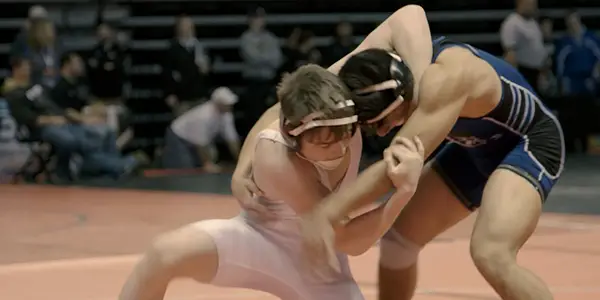WRESTLE: Grappling With Balance

Arlin is an all-around film person in Oakland, CA. He…
Sports have always been a natural fit for the documentary treatment, as conflict and narrative are both inherent within them. That’s why U.S. olympic coverage is so often peppered with lengthy segments about the years of training and obstacles overcome to reach the international stage, or why we have feature docs on everything from basketball to spelling bees to the competitive chicken circuit. But with the exception of last year’s slick short Zion, wrestling has yet to get a similar cinematic treatment.
Directors Suzannah Herbert and Lauren Belfer sought to remedy that by embedding themselves in Huntsville, Alabama with the wrestling team at the failing J.O. Johnson High School. Following four of the team’s top wrestlers and often their coach, the filmmakers sought to present a collage of contemporary southern poverty through the lens of the thoroughly American institution of high school athletics.
Tough to Pin Down
Wrestle opens with boys screaming in exhaustion, riding piggy-back on each other up a steep hill as lightning fills the night sky. This sequence introduces Sinisa Kukic‘s deft framing, foregrounding the boys in the shadows, while behind them lies a brightly lit baseball field, perhaps a sly comment on the two sports’ relative places in the public consciousness. Much of the implicit connotations of the film are delivered through Kukic‘s lens, telling the audience a great deal about the world of the film through quiet shots of chain link fences and worn walls.

After that striking initial sequence, the filmmakers introduce their protagonists at a machine-gun clip, offering the merest glimpses of their characters before launching back into their grueling training regimen and the larger wrestling narrative. Jamario has girlfriend drama, Teague has always wanted to wrestle, Jaquan is on punishment, and Jailen gets his hair cut every week. Before we get a chance to really care about any one of the four wrestlers or any associated stakes, we’re thrust back into the competition.
The film tries to help the uninitiated understand the proceedings with captions like “out of bounds” and “win by points”, but it’s still difficult to get a sense of the action with the obscure ruleset and frequent cutting, likely a side-effect of occupying the mindset required to create a 90 min film from over 600 hours of footage. This back and forth between the sport and the lives of those playing it is where Wrestle often struggles.
Once we finally settle in and accept that Wrestle is so-titled for a reason, the filmmakers then bring us back out to attempt further character development. The film was shot over a single season and one wonders if that was perhaps enough time for the filmmakers to build a necessary rapport with their many subjects, which was clearly their aim having moved to Huntsville full-time during production.

For instance, in one scene the team’s coach picks up a crying Jamario at his house, but we don’t get the details as to what caused his mood until much later, after this particular incident has been forgotten. While it’s almost always true in a documentary that the viewer has less knowledge of a given situation than those living it, the feeling that there’s more happening than the film is able to present is a common one.
This dichotomy between life on and off the mat is played out aesthetically as well. For instance in the first wrestling portions, the score strives for an inspirational tone, playing over the coach’s speech in a grand fashion that might not be out of place in a sports drama like Remember the Titans. But then in parts exploring the wrestlers personal lives, there are twangy guitar riffs that wouldn’t sound out of place on Twin Peaks. The film covers so much, deficiencies in school resources, familial pressures, institutional racism, social tensions, wrestling, but their presentation is largely unbalanced and perhaps even slightly jarring.
Wrestle: Conclusion
Wrestle is admirable in its aims but seems to have largely succumbed to the weight of its scope and themes. With this many subjects there’s no reason for the standard runtime, which sees that none of them ever get fully fleshed out aside from arguably Jamario, who is mostly defined by his relationship with his girlfriend Samara. Whether by cutting back open its subjects or allowing for a longer film, Wrestle, like those it depicts, could have almost certainly benefited from some room to breathe.
It’s a film that partially relies on its subject matter and familiar story beats to do some of the heavy-lifting. Instead, those elements more often highlight some of the film’s structural deficiencies because comparable docs of this type are plentiful. At times while watching the film I couldn’t help but think about Hale County This Morning, This Evening (which, to be fair, I find myself doing most days), a documentary that also dealt with sport, Alabama poverty, and racial dynamics, but eschewed many established conventions of other films that did the same. Wrestle does shine in some individual moments, and it’s by no means a bad film, but it is one that ultimately feels more montage than collage.
Wrestle was released in the USA on February 22.
Does content like this matter to you?
Become a Member and support film journalism. Unlock access to all of Film Inquiry`s great articles. Join a community of like-minded readers who are passionate about cinema - get access to our private members Network, give back to independent filmmakers, and more.
Arlin is an all-around film person in Oakland, CA. He received his BA in Film Studies in 2010, is a documentary distributor and filmmaker, and runs Drunken Film Fest Oakland. He rarely dreams, but the most frequent ones are the ones where it's finals and he hasn't been to class all semester. He hopes one day that the world recognizes the many values of the siesta system.













